
The Platycnemididae are a family of damselflies. They are known commonly as white-legged damselflies. There are over 400 species native to the Old World. The family is divided into several subfamilies.

Anaciaeschna is a genus of dragonflies in the family Aeshnidae. Species of Anaciaeschna are found in Africa, Asia and Australia.

Argiocnemis is a genus of damselfly in the family Coenagrionidae. Species of Argiocnemis are generally small to medium-sized damselflies, darkly coloured with pale markings. They occur in Africa, Indian Ocean islands, South-east Asia, New Guinea and Australia.

Gynacantha is a genus of dragonflies in the family Aeshnidae. The females have two prominent spines under the last abdominal segment. This gives the genus name and the common name two-spined darners; they are also known as duskhawkers.
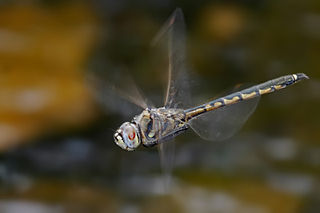
Hemicordulia is a genus of dragonfly in family Corduliidae. It occurs in Africa, southern Asia, Australasia and Pacific Islands such as the Bonin Islands, Fiji and French Polynesia. Species of Hemicordulia are small to medium-sized dragonflies, coloured black or metallic, with yellow.

Indolestes is a genus of damselflies in the family Lestidae. Species of Indolestes can be medium-sized, dull coloured dragonflies. They are found from India through Asia, Australia and the Pacific.
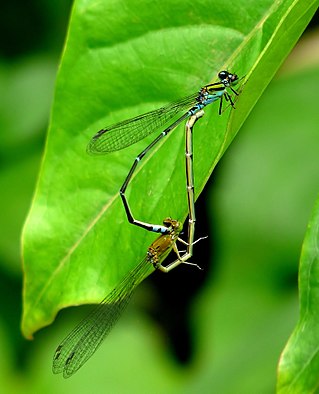
Pseudagrion is the largest genus of damselfly in the family Coenagrionidae, with over 140 species. Its range includes most of Africa, much of Asia, and Australia. Africa holds most of the diversity with almost 100 species. It has occupied most of the freshwater habitats in its range, and dominates damselfly communities in habitats as different as desert pools, equatorial rainforests and montane streams.

Teinobasis is a genus of damselflies in the family Coenagrionidae. Species occur in south-eastern Asia, Indonesia, Solomon Islands and Micronesia; one species, Teinobasis rufithorax, is found in Australia.

Tramea is a genus of dragonflies in the family Libellulidae, the skimmers and perchers. Species of Tramea are found in tropical and subtropical regions around the globe. They typically have colored bases to their otherwise translucent hindwings. In particular when they fly, this creates the impression of their carrying bags at the start of their abdomens. They are known commonly as saddlebags or saddlebags gliders.

Rhadinosticta is a genus of damselfly in the family Isostictidae, endemic to eastern Australia. Species of Rhadinosticta are slender, medium-sized damselflies, with a dull colouring.
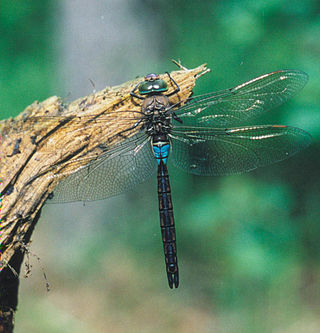
Anax is a genus of dragonflies in the family Aeshnidae. It includes species such as the emperor dragonfly, Anax imperator.

Nannophlebia is a genus of dragonfly in the family Libellulidae. They are commonly known as Archtails. The species are very small with black and yellow striped abdomens.
Agyrtacantha is a genus of dragonflies in the family Aeshnidae. Species of Agyrtacantha can be large, dull-coloured dragonflies.

Eusynthemis is a genus of dragonflies in the family Synthemistidae. They are commonly known as tigertails. Species of this genus are found mostly in Australia with one species, Eusynthemis frontalis, found in the Solomon Islands.
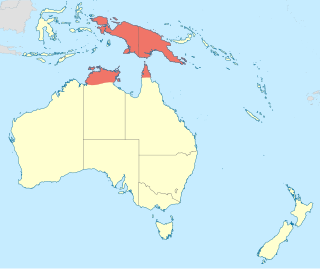
Orthetrum balteatum is a freshwater dragonfly species in the family Libellulidae, present in northern Australia and New Guinea. The common name for this species is speckled skimmer.

Procordulia is a genus of dragonfly in the family Corduliidae. Procordulia are found in Southeast Asia, New Guinea, Australia, New Zealand and parts of the Pacific region.

Aethriamanta nymphaeae is a species of dragonfly of the family Libellulidae, commonly known as the L-spot basker. It inhabits lagoons ponds and swamps across northern Australia.
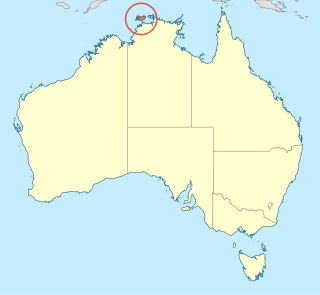
Huonia melvillensis is a species of dragonfly of the family Libellulidae, known as the forestwatcher. It is the only species of Huonia in Australia, where it has been found on Melville Island, Northern Territory. It inhabits pools in streams. It is a small dragonfly with black and pale green markings and a clubbed abdomen.
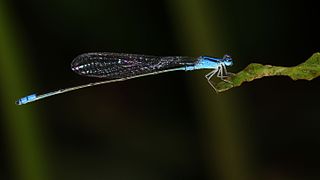
Archibasis is a genus of damselflies belonging to the family Coenagrionidae. These damselflies are generally medium-sized with bright colouring. Archibasis occurs in southern Asia, Indonesia, New Guinea and Australia.

Austroagrion is a genus of damselflies belonging to the family Coenagrionidae. Species of Austroagrion are small damselflies; males are black with blue or green markings while females are paler. Austroagrion occurs in Papua New Guinea, New Caledonia and Australia.


















